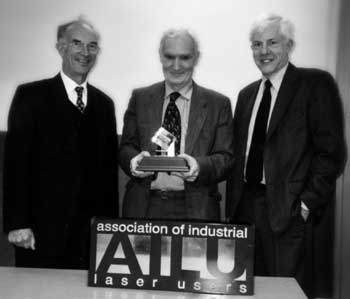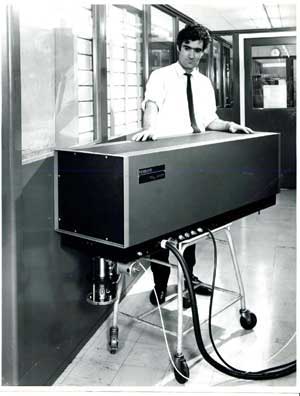2001 - David Dyson

The AILU AWARD for 2001
went to
David Dyson
during the 19 September Members’ meeting at the Rutherford Appleton Laboratory.
This Award is an outstanding contribution to the industrial use of laser in the UK.
The presentation was made by President Tim Weedon at the AILU ‘Laser Sources and Beam Delivery’ workshop at UMIST on 4 November. However, Colin was not well at the time, so Martyn Knowles of Oxford Lasers received the Award on his behalf.
Martyn thanked Micrometric Techniques and Rofin, who between them had produced the award, and outlined Colin’s long career in lasers, spanning over 4 decades.
Gordon Freeman, General Manager of Ferranti Photonics in Dundee, where David spent most of his working life, set the scene by giving a review of David’s work and the history of the MF400, the source that David had played such an important part in developing and claimed as the world's first industrial CO2 laser. He described the many challenges of the early years, of the pivotal role played by BOC in supporting the development of the laser and of the first application of the laser in die-board cutting.
One of several humorous incidents Gordon recounted from the early 1970s was of himself and Neil Forbes visiting the purchasers of their first MF400, Plascut of Rotherham, with a potential client, only to find the laser swinging from a rope above the cutting table while some plasma cutting was taking place. Despite his and Neil’s worst fears, once the laser was replaced on the gantry it worked fine - a testimony to the success of the folded-path resonator to which David had made such a major contribution. The laser won a Design Council award in 1975 and went on to be one of the most popular, especially in the dieboard industry.
“About 500 MF400’s have been produced,” said Gordon “and there are still many in use around the world.” On accepting the award, David said that, having been awarded the Duke of Edinburgh prize in 1975 for this work, he did not expect lightening to strike in the same place twice. He particularly thanked members of AILU who had remembered him after so many years.

David Dyson in 1975 with the Ferranti MF400, claimed as the world's first CO2 laser
and most certainly the best known.
David started work in 1963 in the Laser Group of the Ferranti Valve Lab in Edinburgh, under the late Neil Forbes, two years before the first reports of CW CO2 laser operation. The group's commercial involvement in CO2 lasers began by supplying a design based on work carried out at SERL Baldock to produce a system for RRE, Malvern, a 'conventional' slow flow device with a water-cooled AC (50Hz) excited gas discharge. The main feature of the design was the electrode which acted as a coupling between successive tubes and also between the inner and outer tubes forming the water jacket. As such, the electrode was itself water cooled. Any number of tubes could be coupled together. Each had to be supported, at the electrodes and mirrors, on suitable floor stands. The customers specified how many sections they required. David became seriously involved with this project in 1968, and over a number of design developments became instrumental in solving problems leading up to the optically-folded 12-section designs of the MF400.
BOC bought one of the early Ferranti folded systems for their Welding Research Laboratory in Cricklewood and won a contract to supply Thynes of Edinburgh with a laser die-board cutting machine.
This was based on a line-following guidance system, with Ferranti supplying the laser, comprising four in-line 1 metre long sections, providing in excess of 200W. There were problems to overcome, including the suppression of high order modes, prevention of damage to O-ring seals, the use of composite electrode design to reduce overheating, electrical breakdown of the mirror block insulation and electrolytic attack of aluminium in the water cooling channel in the output window support. Despite all this BOC made their first delivery in the summer of 1970. Work on these systems continued throughout 1970 and beyond, but the work that led to the MF400 began in late 1969. "I recall feeling that given the scale of new problems which seemed to arise from any new design, it was important that the design on which we were working must ultimately be worth the effort. It had always been felt that we must eventually make the system more compact, by increasing the number of folds and I though it important that we make a start as soon as possible rather than get involved in any further unfolded or single-fold designs." said David.
"One of the problems in any conventional design, but particularly when considering folded systems with long overall discharge length, is electrical insulation. One attractive solution was to use two discharges per leg and to isolate these from each other at the centre with a short dead space between a central pair off live electrodes, allowing all the end electrodes and mirrors to be essentially grounded. This also had the advantage of greatly simplifying the power supply design since a single HV source could be used. An experiment was set up in December 1969 to test this, using two BOC-style tubes. This showed that, provided that applied voltage had a sufficiently short rise time, the discharges could be initiated correctly with a dead space of only about 10% of the overall length."
"The original plan had been to make use of the advantages of corner-cube folds, but zigzag (single mirror) folds proved to the most successful." said David. "The simplicity of the fold meant that cost advantage, that of wasted length, was not significant."
The first MF400 was delivered to Plascut in Rotherham in 1901 and David set about converting what was essentially an experimental rig into an engineering design. "What had initially attracted Plascut was the possibility of mounting the MF400 head directly on the beam of a plasma-cutting machine, avoiding the need for moving the workpiece of using moving mirrors. Although this possibility had not been considered originally, and was certainly not the original motive for producing a small design we were able to take account of it in the design of the suspension for the cavity support structure".
"Looking back, it does seem that my original concern that nay new design would lead to a range of problems was even more prophetic than intended. This seems to have been the experience of many laser manufacturers, Although it is inevitable that there will be some problems, I wonder if this may partly reflect the difficulties bringing together and coordinating the very wide range of engineering skills needed, ranging from optical and electrical to mechanical, heat and fluid flow." said David.
"I have enjoyed meeting the intellectual challenges presented, as well as meeting many customers." commented David adding, with characteristic modesty, "I am aware that the opportunity I had does not come to everybody and that there is an element of luck in being in the right place in the right time."

